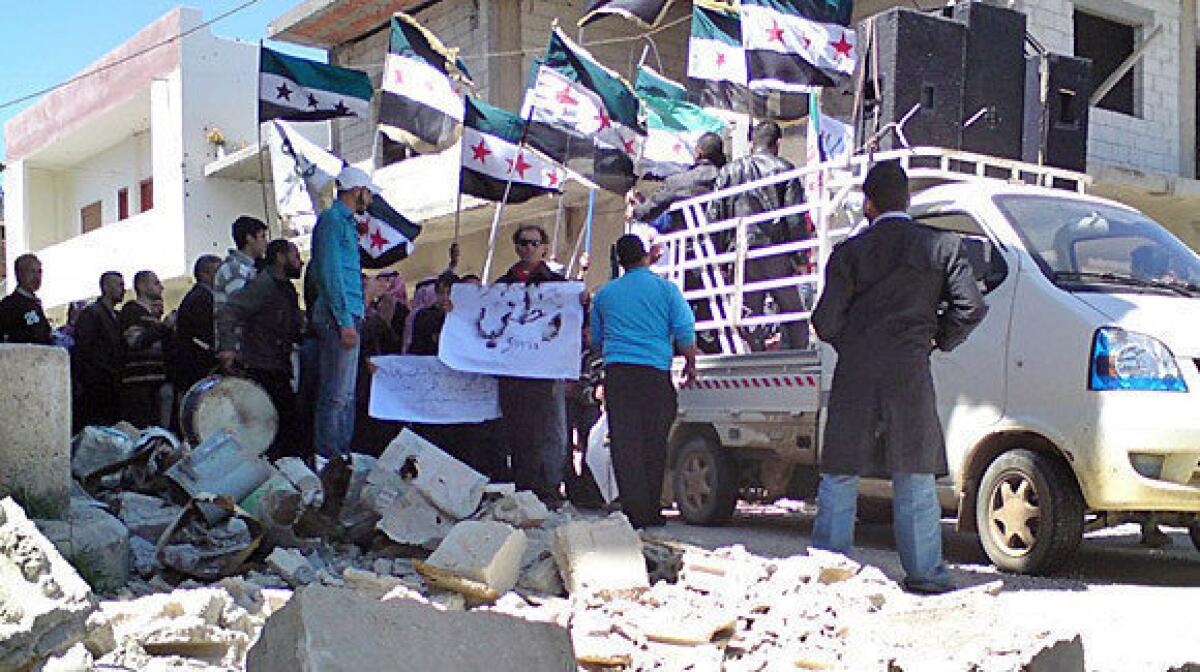Syria cease-fire violations reported, including killings

- Share via
BEIRUT — Two days into a fragile truce, and the question many are asking is, when is a cease-fire no longer a cease-fire?
On the second day of a United Nations-backed peace plan to end violence and unrest in Syria’s 13-month uprising, mass protests returned to the streets and in some places were met with gunfire, killing at least eight people, according to activists.
In other towns, soldiers and security forces stationed nearby allowed protesters to gather, but the very presence of armed government forces was a violation of the plan.
In an attempt to preserve the peace plan set forth by Kofi Annan, the special envoy for the United Nations and the Arab League, the U.N. Security Council was to meet Saturday to vote on a resolution to send an advance monitoring mission of 30 unnamed observers to Syria.
“At the moment, we have the advance team standing by to board planes and to get themselves on the ground as soon as possible,” Annan’s spokesman, Ahmad Fawzi, said Friday.
Of the troops and weapons still positioned in Syrian towns, Fawzi said that “they don’t belong there; they didn’t belong there in the first place and they don’t belong there now.”
Some had hoped the resolution on monitors would be adopted Friday, but debate stalled as Russia’s envoy objected to a provision that called for the Syrian government to be held accountable for human rights violations, among other sticking points, officials said.
“There are tough talks ahead,” said a Security Council diplomat who spoke on condition of anonymity in order to freely discuss the deliberations.
Diplomats “made some progress” on the resolution, the official said, going “paragraph by paragraph” trying to come to agreement on the wording.
Syrian allies Russia and China have both vetoed two Security Council resolutions that condemned the Syrian regime’s violent crackdown on protesters and rebel groups.
Annan has said he would like to see up to 250 U.N. monitors in Syria to ensure that rebel fighters and President Bashar Assad’s government abide by the terms of the cease-fire.
The Local Coordination Committees, an activist network, said that Syrian government forces had defied the truce by their presence in no fewer than 67 sites, as well as by shelling or bombing several cities.
Syria’s delegate to the United Nations, in turn, said that “armed terrorists” had violated the agreement eight times. Syrian state media reported several attacks, including an army major shot in his car and rebels hurling dynamite at police patrols.
Clashes were reported early Friday in a town in Idlib province near the Turkish border, but there was conflicting information about the circumstances. An activist in Idlib said the army stormed the town, shooting at buildings, homes and shops, trying to instigate fighting.
“There was no shooting from the Free Syrian Army side. They are committed to the cease-fire,” the activist said, referring to a rebel force made up of government soldiers who defected. No one was injured, the activist said.
Another activist, in Damascus, said security forces were stationed throughout the capital and prevented people from protesting in some neighborhoods.
But in several others cities, large demonstrations took place calling for the fall of the regime. Security forces opened fire on protesters and one person was killed in Dariya when he was shot by a sniper, activists said.
“The Free Syrian Army stopped shooting, but the regime’s army has not stopped shooting,” an activist named Moaz said. “When the security forces stop shooting … it will go back to being a peaceful revolution.”
Brian Bennett in the Washington bureau contributed to this report.
More to Read
Sign up for Essential California
The most important California stories and recommendations in your inbox every morning.
You may occasionally receive promotional content from the Los Angeles Times.










